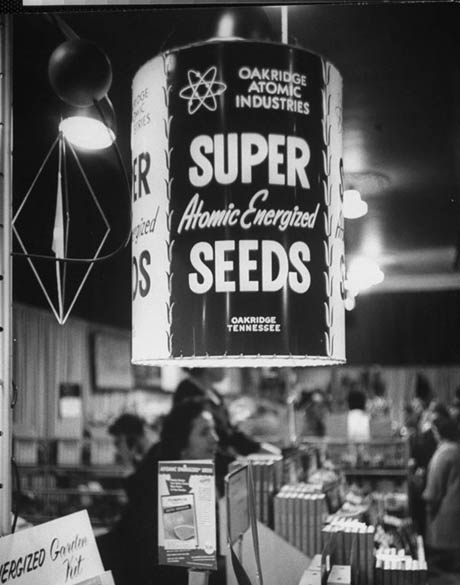
IMAGE: Garden show display advertising “super atomic energized seeds,” photo by Frank Scherschel for Life, 1961, via Pruned
At her blog, Garden History Girl, Paige Johnson (by day, a nanotechnology researcher at the University of Tulsa), describes the inception of the Atomic Gardening Society:
In March 1959, an unusual group of scientists, government officials, and lesser worthies assembled for a dinner party in the dining hall of the Royal Commonwealth Society, London. Unbeknownst to them, one of the courses was a strange strain of American peanuts: ‘NC 4x,’ ‘North Carolina 4th generation X-rayed’ peanuts, produced from seeds that had been exposed to 18,500 roentgen units of x-rays in order to induce mutations. The irradiated peanuts were unusually large — big as almonds, according to those in attendance, outshowing the British groundnuts served alongside — and had reached the dining table through the generosity of their inventor Walter C. Gregory of North Carolina State College, who sent them as a gift to Mrs. Muriel Howorth, Eastbourne, enthusiast for all things atomic.
Disappointed with the reaction of her guests, who were less than appreciative of the great scientific achievement present at table, Muriel afterwards “began inspecting [the] uncooked nuts wondering what to do with them all … I had the idea to … pop an irradiated peanut in the sandy loam to see how this mutant grew.” The “Muriel Howorth” peanut (for she had already named it after herself) germinated in four days and was soon two feet high. She called the newspapers.
Shortly thereafter, in a blaze of enthusiasm, Muriel formed the Atomic Gardening Society (with herself as president) and even published a how-to-guide, Atomic Gardening, in order to “co-ordinate and safeguard the interests of ATOMIC MUTATION EXPERIMENTERS who would work as one body to help scientists produce more food more quickly for more people, and progress horticultural mutation.”
As Johnson explains, this interest in using nuclear radiation in plant breeding to induce helpful mutations “grew out of post-WWII efforts to use the colossal energy of the atom for peaceful pursuits in medicine, biology, and agriculture. ‘Gamma Gardens’ at national laboratories in the US as well as continental Europe and the USSR bombarded plants with radiation in hopes of producing mutated varieties of larger peanuts, disease resistant wheat, more sugary sugar maples, and African violets with three heads….”

IMAGE: An atomic seed packet, provided by Paige Johnson, via Pruned.

IMAGE: Atomic seeds on sale, photo by Frank Scherschel for Life, provided by Paige Johnson, via Pruned.
Following from his own week of atomic tourism, tracing the ruins and erasures of Nike missile sites that encircle Chicago, Alexander Trevi of Pruned has posted a lengthy and fascinating interview with Johnson, on her continuing efforts to research this neglected piece of nuclear history. In it, Johnson explains that, aside from its obvious retro-futuristic appeal, the story of the Atomic Gardens is particularly compelling for its citizen science component, as well as its potential to offer a historical perspective on the inflated claims of GM-boosters today.
As she points out, “It’s clear from reading the primary sources that most people involved were deeply sincere. They really thought their efforts would eradicate hunger, end famine, prevent another war.” These are eerily similar claims to those we hear from the Gates Foundation, for example, as they pour millions into the development and propagation of transgenic Golden Rice and BioCassava Plus.
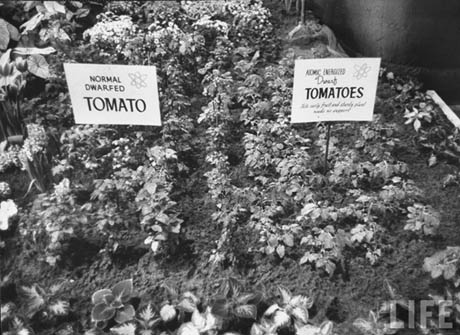
IMAGE: “Normal” dwarf tomatoes growing alongside “atomic energized” dwarf tomatoes, photo by Frank Scherschel for Life, via Pruned.
In addition to encouraging a necessary scepticism in our contemporary debate, the story of the atomic gardens also provides a positive example of the value of transparency and public engagement in the debate over altered crops. As Johnson explains to Pruned:
I think one way that science has failed the public is by not making its results accessible, often with the implicit — even explicit — excuse that non-scientists somehow aren’t smart enough to understand them, which is self-serving tosh. It’s interesting that public engagement was desired, and sought out, during the Atoms for Peace program of which the atomic gardens were a part. It was a time when the atomic scientists who had been sequestered during the war began to speak strongly into the public sphere about their science and its implications, to enter the cultural discussion in the way that these atomic experiments — which are still ongoing — should now.
The story of these citizen-pioneers of mutagenesis (the technical term for creating genetic change through the application of chemical, physical, and biological agents) is full of fantastic details, from Muriel Howorth’s propagandising ballet-mime, Isotopia, which involved a cast of Knowledge, Electron, Proton, Neutron, Rat, and Cow, as well as a working geiger counter, to Tennessee-based atomic entrepreneur C.J. Speas irradiating trays of seedlings into his backyard bunker.

IMAGE: C.J. Speas giving a tour of his radioactive bunker to high school students, photo by Grey Villet for Life, via Pruned.

IMAGE: Speas with a tray of irradiated seedlings, photo by Grey Villet for Life, via Pruned.
Perhaps the most bizarre detail in the interview, however, is the news that these gamma gardens are still in operation, relatively unchanged in design since the 50s, in the grounds of national laboratories today. Their circular form, which, as Johnson notes, bears more than a passing resemblance to the atomic danger symbol, “was simply based upon the need to arrange the plants in concentric circles around the radiation source which stood like a totem in the center of the field.”
It was basically a slug of radioactive material within a pole; when workers needed to enter the field it was lowered below ground into a lead lined chamber. There were a series of fences and alarms to keep people from entering the field when the source was above ground. The amount of radiation received by the plants naturally varied according to how close they were to the pole.
So usually a single variety would be arranged as a ‘wedge’ leading away from the pole, so that the effects of a range of radiation levels could be evaluated. Most of the plants close to the pole simply died. A little further away, they would be so genetically altered that they were riddled with tumors and other growth abnormalities. It was generally the rows where the plants ‘looked’ normal, but still had genetic alterations, that were of the most interest, that were ‘just right’ as far as mutation breeding was concerned!
Over at GOOD, Peter Smith recently described a similar layout at the still-active Institute of Radiation Breeding, in Hitachiohmiya, Japan, which has “has a 88.8 Terabecquerel Cobalt-60 source, ringed by a 3,608-foot radius Gamma field (the world’s largest), and a 28-foot high shield dike around the perimeter.”

IMAGE: A gamma garden at Brookhaven National Labs, New York, c. 1958; image provided by Paige Johnson, via Pruned.
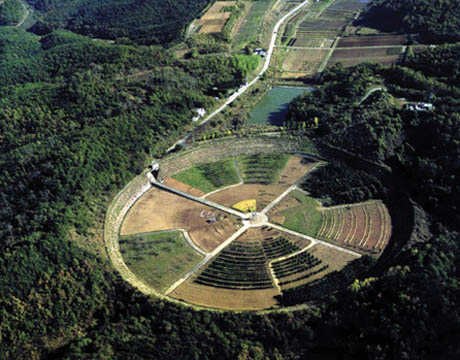
IMAGE: Aerial view of the Institute of Radiation Breeding, Hitachiohmiya, Japan.
As it turns out, far from being a fantastic fossil from the future that never was, along with jetpacks and flying cars, atomic gardening is alive and well today. According to a 2007 New York Times story, which quotes Dr. Pierre Lagoda, head of plant breeding and genetics at the International Atomic Energy Agency, radiation breeding is actually experiencing a renaissance, due to the introduction of “new methods that speed up the identification of mutants.”
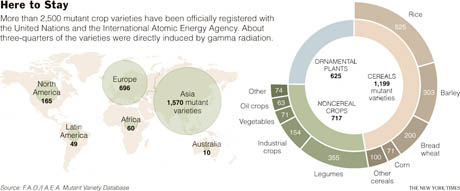
IMAGE: Mutant crop varieties mapped by The New York Times.
What’s more, the Times adds, nearly 2,000 gamma radiation-induced mutant crop varieties have been registered around the world, including Calrose 76, a dwarf varietal that accounts for about half the rice grown in California, and the popular Star Ruby and Rio Red grapefruits, whose deep colour is a mutation produced through radiation breeding in the 1970s. Similarly, Johnson tells Pruned that “most of the global production of mint oil,” with an annual market value estimated at $930 million, is extracted from the “wilt-resistant ‘Todd’s Mitcham’ cultivar, a product of thermal neutron irradiation.” She adds that “the exact nature of the genetic changes that cause it to be wilt-resistant remain unknown.”
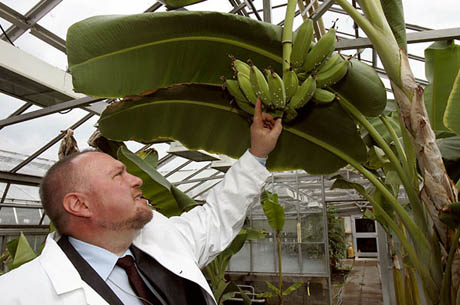
IMAGE: “Pierre Lagoda, the head of plant breeding and genetics at the International Atomic Energy Agency, showing mutated plants at a greenhouse in Austria,” photo by Herwig Prammer for The New York Times.
What’s so intriguing about all of this, in terms of the current debate on “Frankenfoods,” is that mutagenesis helps add some much-needed shades of gray to the idea of genetic manipulation. Speaking to The New York Times, Dr. Lagoda is quick to point out that unlike Monsanto’s biotechnologists with their insertion of primrose genes into soybean DNA, he is “not doing anything different from what nature does.” Meanwhile, as Zackery Denfeld of the Center for Genomic Gastronomy pointed out to me over email, “partisan pro-GM advocates rely on the rhetorical stance that mutagenesis is non-directed and thus much more dangerous than transgenesis.” And, just for context, it’s always worth remembering that our orange-coloured carrots and leafy kale are already the result of intentional genetic design, carried out through centuries of selective breeding.

IMAGE: A new classification system for various types of genetically modified organisms proposed by scientist Kaare M. Nielson, via.
In fact, attempts to classify degrees of genetic mutation, from conventional breeding all the way to the creation and insertion of artificially synthesised genes, are the subject of continuing debate, which is heightened by the significance of particular labels in consumers’ minds and the resulting economic impact.
For example, a mutagenic Ruby Red grapefruit grown without the use of pesticides can be labeled as organic and thus be sold for a premium, despite the fact that organic foods by definition cannot be genetically modified. Meanwhile, in Europe, where genetically modified crops are banned, some researchers have argued that disease-resistant strawberries produced through cisgenesis (in which new varietals are created by artificially transferring genes between organisms that could — but haven’t — bred “naturally”) should be allowed to enter market in the same way as conventional crops, as opposed to being regulated as GMOs.

IMAGE: Cisgenesis Volume 1: The Social Life of Scientific Nomenclature, edited by Zachery Denfeld and designed by Tara Kelton and Lauren Francescone, available for purchase at the Center for Genomic Gastronomy.
Denfeld has actually created a remarkable book that documents “every change on the Wikipedia page for Cisgenesis from when it was first created at 22:48 on February 22, 2009, until 16:31 on November 4, 2010,” as a way to explore the shifting ground between “natural” and “artificial” that lies at the heart of this debate.
With his Center for Genomic Gastronomy, Denfeld also creates provenance maps and recipes for transgenic foods; meanwhile, fellow biohackers at Genspace, the world’s first government-compliant community biotech lab, have been inserting jellyfish genes into yogurt using nothing more than a plastic salad spinner and Ziploc bags. These noble efforts, perhaps, are the twenty-first century version of Paige Johnson’s backyard atomic gardeners: solo enthusiasts whose work attempts to draw the conversation around advances in plant breeding technology out from behind the closed doors of private enterprise and into the public realm, where it belongs.
NOTE: I highly recommend visiting Pruned to read Trevi’s interview with Johnson in full — there are many more amazing images and details. Thanks also to Peter Smith and Zackery Denfeld for the email conversation. And if you’re in London, don’t miss Paige Johnson’s talk at the lovely Garden Museum on June 7th.
2 Comments
I must say I am confused by Zack’s argument here. I understand what he is saying, but I am confused about why he is attempting to debunk a strawman argument by setting up another strawman argument?
The comparison between GE crops and mutagenized crops addresses essentially one question – and that is the risk of unintended consequences by means of the method of genetic modification. Both GE and mutagenesis can alter the expression of other genes in the genome of the plant, as does plant breeding itself. Some arguments against GE are based on the possibility that an unwanted gene could be up-regulated (or a wanted gene could be down-regulated) meaning that there is a risk of an undesired effect. But if you read the literature comparing these two, you will find that GE comes out on top, whereas mutagenesis causes far more unintended changes throughout the genome. Actually, even regular plant breeding can cause more unintended consequences – even deterimental ones. A recent study on apples in 2010 found that breeding a gene for fungus resistance the normal way caused more negative effects on the local environment than picking up and moving the gene with genetic engineering. This is because breeding brought over other, undesired genes. References for these and more are available on Biofortified on this page:
http://www.biofortified.org/genera/studies-for-genera/
Now I would like to address how Zack’s argument is a straw-man. While someone talking about GE vs mutagenesis is arguing strictly from the standpoint of a comparison of genetic methods – Zack believes that the important part is how a crop is used after it has undergone that modification. A Straw-man argument is an argument that is obviously false that is stood up and knocked down easily to give the perception that the arguer has addressed their opponents. If someone was trying to argue that GE was better than mutagenesis on a larger political perspective because of the lower risk of unintended consequences then that would be a non-sequitur – an argument that does not follow from its premises. I have never heard anyone try to argue that. So ironically, to address the GE-mutagenesis comparison, Zack has set up a straw man of his own – that this comparison on the basis of relative risks is somehow put up to address the wider political issues, when it is not.
If we were to talk about some of the societal and political issues in the comparison of mutagenesis vs GE, I think it would be entirely appropriate to ask the same questions that he does about GE. how about the question of ‘What do mutagenized foods taste like?’ And ‘How are mutagenized crops used?’
Are GE crops just vending machine foods?
I think Zack is being a little disingenuous when he describes GE crops thus, because the ‘vending machine junk food’ taste has nothing to do with the specifics of the modification itself, and he is purposefully choosing only one (disappointing) category of foods derived from GE crops to reach that conclusion. For instance, GE virus-resistant Papaya grown in Hawaii, to me, would taste like an important part of a Papaya Salad when unripe, or a yellow or red Thai Curry when ripe. Dried, it can find its way into trail mix. GE virus-resistant squash (zucchini, crookneck) is of course excellent on a barbecue skewer next to mushrooms, onion, and your choice of meat/substitute, slathered in barbecue sauce. The meat substitute might be made from GE soy, even. On the subject of corn, you could eat it in the form of a loaf of cornbread or how about sweet corn in the summertime? It could be grilled next to the previously-described kabobs. Finally, given that there are also plenty of junk foods in vending machines that are made from say, organic sources, would it at all make sense to say that organic tastes like junk food? There is nothing fundamental to GE crops that makes it more suitable for making vending machine food than other methods of crop modification. There is a reason why we find genetic engineering applied to the commodity crops first before many other crops – they are the largest seed markets, providing the largest opportunity for the companies that make them to get a return on their investment in developing the GE trait. There’s nothing inherently commodifying about GE versus other genetic techniques.
I think it is entirely appropriate to talk about how GE and other methods are used, and how they fit into the food system. But it is really difficult to say that GE gets some of the blame for obesity, given that the path connecting those two is indirect and not a necessary consequence of the GE traits. Perhaps you could argue that making corn and soy continue to be profitable and thus grown on a wide acreage has not helped those who are trying to diversify the American diet, but we would still have the same vending machine junk foods with or without the GE versions of these crops. Maybe they would be a little more expensive without GE. But I once heard Belinda Martineau, a critic of GE, admit in a public forum that GE seems to get the blame for all the ills of conventional agriculture. (unfairly) Since mutagenesis has helped corn and soy breeding as well – does it also get some of the blame for obesity? Breeders are also trying to bring in genetic diversity from landraces and wild relatives – if this genetic diversity also helps grow more corn and soy or protect it from disease, is genetic diversity also in-part responsible for obesity as well? How about refrigerators?
Finally, I would like to address the part about “The Purpose of a System is What it Does”, which I will do as a post on Biofortified, more likely next week since I am busy this week with writing. In short, I think as a heuristic it is hardly useful since it provides no new information, and rests on an equivocation between purpose and function. And I don’t think it is appropriately applied to GE since it is not a system but a component of several systems. I’ll use examples from biology because I think they best demonstrate the problems with this line of reasoning as applied to systems.
I am glad to see that Zack has joined discussions on our blog, hopefully more people may become interested in talking about all these issues. We want to get more people from all areas of life communicating about it. Here’s to that!
Apologies for the double-post, I screwed up the blockquote formatting, fixed in this version.
My quote (above) from an email was not subtle enough. (Thanks @geneticmaize for pointing this out).
It probably should have been something like “Comparing mutagenic breeding to transgenesis in debates around GE Food is a strawman argument, because it doesn’t address concerns about the political economy / policy / implementation of GE Food, nor does THIS argument point to empirical evidence of how either of these technologies have been DEPLOYED thus far” instead of what I wrote originally: “partisan pro-GM advocates rely on the rhetorical stance that mutagenesis is non-directed and thus much more dangerous than transgenesis.” Sorry about that. 🙂
The difference between “matters of fact” (i.e. “In most cases mutagenesis causes more unintended phenotypical changes than transgenesis.”) and “matters of concern” (i.e. “Transgenic plants should be grown because they are “less dangerous” than mutagenic plants”) are vast.
Matters of fact can be answered using the scientific method but Matters of Concern can only be answered using politics: including IN PART all of those nasty subjective and a-rational tools and bounded mental models we use to make decisions in a world of limited information, time, and resources: preferences, biases, assumptions, rules of thumb, heuristics, tradition etc.
This is not to say Empiricism should not be utilized in Matters of Concern. In fact, I advocate a much more empirical approach to food system design, policy and action. I am continuously shocked by Molecular Biologists & Agronomists who enter in debates about “Food Policy” that make statements based primarily on preferences, biases and assumptions about the future, rather than the empirical study of Food Policy and Production as it happens on the ground.
Any empirical approach to food policy would have to include observations / ethnographies of current food system practices (production, transportation, processing, consumption…etc.) at local, regional and international levels. This kind of work and knowledge from observational social science and fieldwork of the present gets less attention, funding and is valued differently than claims about the future made by Scientists / Technologists. (I can dig up some sources to support that claim if desired). One interesting source to see these debates play out is: http://www.biofortified.org/ which has the tag line “Stronger plants, stronger science, stronger communication.”
One can see right from the self-representation of this debate-space that the emphasis is on plant science, plant technology and plant science&technology communication. And yet, many of the debates that happen on these pages are questions of politics, policy, culture & sociology. I am all for multi-disciplinary dialogue, but it has to actually include disciplinary tools and lenses from MULTIPLE disciplines. That is why I have tried to participate in the debates on BioFortified, http://thescientistgardener.blogspot.com/ twitter, and others. My background is primarily Art, Design & Public Policy, but I have also done due diligence: spending a lot of time learning about and understanding the basic domain knowledge of Molecular Biology, Agronomy, Ecology and Ag. Policy in the U.S. the E.U. and India.
In Matters of Concern around the implementation of transgenic technology of food crops, I try to generate interesting questions. (Artists being “Problem Seekers” after all.) Asking “Are you For or Against GE Crops?” is a rather uninteresting question because it contains a yes or no answer. Instead at the Center for Genomic Gastronomy we have attempted to ask three primary interesting questions:
* “What do GMOs taste like?”
* “Who benefits from Agricultural BioDiversity?”
* “How are non-humans effected by changes in the human food system?”
Empirical evidence for the question “What do GMOs taste like?” is different depending on what country you are in, but in the U.S. it appears from my observations that GMOs taste like junk food. The majority of GE crops grown in the U.S. are field crops that are fungible commodities that are converted into feed, industrial inputs, or that are processed into industrially produced, and branded foods. This might be an unintended consequence of employing transgenesis, but looking at quantitative evidence about crop production, and my own empirical observations about what kinds of food GE crops get turned into (stuff in the vending machine), leads me to believe the outcome of growing GE crops in the U.S. is not particularly efficacious in dealing with some of the most pressing food system issues: obesity & resilience. When studying complex Social phenomenon one heuristic that I have found useful is The Purpose of a System is What it Does. (see: The Purpose of A (Food) System is What it Does). Obviously this heuristic needs to be reality-checked against other epistemologies or “Ways of knowing” including case studies, quantitative data etc. If one studies the political economy and history of agricultural technology in the U.S. is it any surprise that the majority of GE plants in the ground are fungible commodities that are also hybrids? It probably shouldn’t.
I would not claim that someone working on the creation or deployment of biofortified rice is directly causing this scenario, but empirically, we have a situation where the implementation of transgenic crops within the U.S. have not positively affected matters of concern such as obesity, or local food system resilience, but rather have exacerbated these situations. This is not a reason to ignore what Molecular Biologists or Agronomists have to says, or what the scientific method can produce, but Matters of Concern can not be answered by Science or Scientists alone, they need to involve many actors, methods and voices.
I have tried to point my colleagues in the Humanities, Social Sciences & The Arts who have fears/ reservations about what GMOs ARE to reputable peer-reviewed sources on Matters of Fact relating to Molecular Biology & Agronomy. I look forward to talking to more Scientists & Would-Be policy makers about what kind of empirical resources and tools are available for reflecting on the food system more holistically, rather than just on the Technology side, and asking questions about what GMOs DO in addition to what GMOs ARE.
As a starting point to iterative approaches to Food System action, I am particularly impressed with the work of EcoTrust in studying and addressing matters of fact & addressing matters of concern.
– Zack @ The Center for Genomic Gastronomy